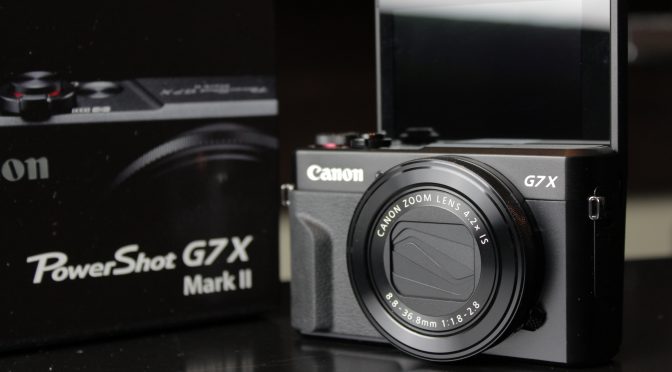Recently I had a chance to use a new camera from Canon, the G7X Mark II, and here is my review of it.
It is a top-of the-line point-and-shoot camera that is perfect for when you can only take minimum gear, but still want to be able to take great photos and videos
The first generation of G7X has been a big hit with the vloggers. It is also perfect for taking family videos and photos, especially when travelling. For myself, I will also use it for behind-the-scenes videos of our indie film and video productions.
-
Here are key features of this camera:
- 1″ CMOS image sensor
- the latest DIGIC 7 Image Processor – first Canon camera with this processor
- 3.0″ inch touch screen that flips 180 degrees for taking selfies; Mark II also tilts down 45 degrees
- fast f/1.8-f/2.8 4.2x Optical Zoom (24-100mm) image stabilized lens
- high-speed AF with 31 focus points
- video in 1080P at 24 fps, 25 fps (PAL), 30 fps (NTSC), 60 fps
- stills at up to 8 fps continuous shooting rate
- file format support: jpeg and RAW for pictures; MP4 for video
- maximum ISO of 12800 (25600 ISO is available in expanded mode, but it is not useful)
- a time lapse function and a built-in ND filter
-
Here is a quick comparison of Mark II vs Mark I:
- DIGIC 7 vs DIGIC 6 image processor
- stills at up to 8 fps vs 6.5 fps continuous shooting rate
- Mark II allows to shoot 1080P at 24 fps
- Mark II touch screen also flips down to 45 degrees
- weight: 320 g vs 303 g
- Bit depth: 14-bit vs 12-bit
The main competitor of the G7X is the Sony RX 100 Mark IV.
-
Here are the key point of how the Sony camera differs from the G7X:
- super good slow motion – 1080P all the way at 250fps
- shoots 4K video (but the camera heats up a lot)
- has faster (i.e. better) autofocus
- supports SLog2
- has an electronic viewfinder (more useful for photographers than videographers)
- it is more expensive
- the image stabilization is not as good. The RX 100 has two modes for IS. The mode with better stabilization (comparable to G7X) also crops the image, resulting in 28mm wide angle framing, instead of 24mm
- has confusing menus, although there is more customization possible
- Colour reproduciton is not quite as good as Canon’s (in my opinion)
My overall verdict on the Canon G7X Mark II?
The camera exceeded my expectations. It is a very good, fun-to-use camera. The image quality is very impressive. Its only shortcoming is the audio, which is typical of cameras that only use internal microphones.
It is a good idea to get extra batteries because the one Canon battery that comes with the camera will last you half a day – if you are lucky. Below are the batteries that I bought. They don’t last quite as long, but given the big price difference, you still get much better value with these third-party batteries.
By the way, when you put a non-Canon battery in the camera, you will get a message asking whether this is a Canon battery. Once you click “No”, you will get another message, this one saying that Canon cannot guarantee the performance of this battery. Despite this message, I have not had any problems whatsoever.
If you area going to have three or maybe even five batteries to charge (I got two of these double packs), a second charger is advisable. I really like the combo that includes the AC charger and the car charger, in addition to the two batteries, and that is what I bought.


I agree with everything except your autofocus statement. From my experience the g7x II has much better af than the Sony. Plus it has the touch to focus feature.